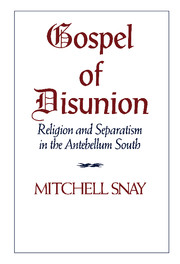Book contents
- Frontmatter
- Contents
- Acknowledgments
- Introduction: Religion and the search for Southern distinctivenes
- PART ONE RELIGION AND SECTIONAL POLITICS
- PART TWO RELIGION AND SLAVERY
- 2 Slavery defended: The morality of slavery and the infidelity of abolitionism
- 3 Slavery sanctified: The slaveholding ethic and the religious mission to the slaves
- PART THREE RELIGION AND SEPARATISM
- Conclusion: Religion, the origins of Southern nationalism, and the coming of the Civil War
- Bibliography
- Index
3 - Slavery sanctified: The slaveholding ethic and the religious mission to the slaves
from PART TWO - RELIGION AND SLAVERY
Published online by Cambridge University Press: 07 September 2010
- Frontmatter
- Contents
- Acknowledgments
- Introduction: Religion and the search for Southern distinctivenes
- PART ONE RELIGION AND SECTIONAL POLITICS
- PART TWO RELIGION AND SLAVERY
- 2 Slavery defended: The morality of slavery and the infidelity of abolitionism
- 3 Slavery sanctified: The slaveholding ethic and the religious mission to the slaves
- PART THREE RELIGION AND SEPARATISM
- Conclusion: Religion, the origins of Southern nationalism, and the coming of the Civil War
- Bibliography
- Index
Summary
As a Presbyterian pastor, educator, and theologian, Robert Lewis Dabney of Virginia had little time to read newspapers. Yet the sectional crisis of 1850 seems to have kindled his political interests. In 1851, he wrote a series of articles on the slavery controversy for the Richmond Enquirer. Earlier that year, Dabney had penned a long letter to his brother in which he mused over the relations between North and South. “This question of moral right,” Dabney insisted, “is at the bottom of the whole matter.” Behind the Wilmot Proviso and the entire Northern effort to stop the spread of slavery in the territories was the simple and basic belief that slavery was wrong. To Dabney, this was a religious and ethical position that was most effectively met by the Bible. Because the Bible defended slavery, pressing the sectional controversy on the Word of God would push the abolitionists “to unveil their true infidel tendencies.” They would be forced to array themselves against the Bible, which would alienate true believers in the North. The end result would be to compel the “whole Christianity of the North” to ally itself with the slaveholding South.
- Type
- Chapter
- Information
- Gospel of DisunionReligion and Separatism in the Antebellum South, pp. 78 - 110Publisher: Cambridge University PressPrint publication year: 1993



